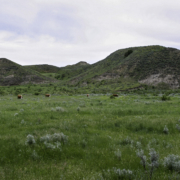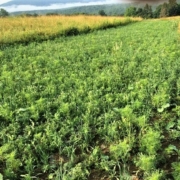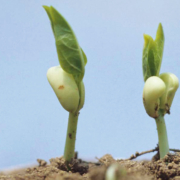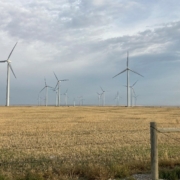Practicing Resurrection: Using Green Manures on a Small Semi-Urban Homestead
 Print This Post
Print This Post
By Lee Rinehart, NCAT Agriculture Specialist
The garden entrance is protected from groundhogs and deer by a mesh-covered wooden gate. On the gate hangs an 18-inch-long pallet board with the words “Mad Farm” painted in green. Inspired by Wendell’s Manifesto, I wanted to instill the place with the contradiction embodied in his poem. To “every day do something that won’t compute… say that the leaves are harvested when they have rotted into the mold.”
The quarter acre I steward in Northeastern Pennsylvania is, I hope, an incarnation of this contradiction. This spring, I planted a seed pack from High Mowing Seeds. Blooming annuals, for their own sake, though I stopped counting pollinator insect species when I got to 20. Now they reach five feet or more above their soil blanket, buds and flowers and stems thick and spindly. There are sunflowers, cosmos, buckwheat. The phacelia has gone, has begun its own return. I watched them last night and considered their being, as individuals. Not as singular flowers, but rather the instantiation of these particular plants in this space. Though I will invite a similar community on the farm next year, and they will be cousins of these plants, these will have passed once again into the soil, their essence to arise in next year’s tomatoes. Knowing these plants, or really maybe recognizing them as individuals has softened my heart some. It has reified the value I place on this farm/garden as a place of connection.
Cover crops are all about connection.
There is a hope here that feeds the soul, as the good fruits of the garden feed the body. It speaks to what I have come to see as fundamental to all human and non-human well-being… namely, the law of return. On the Mad Farm, this is enacted through compost and especially the cover crops that occupy space on the gardens each season. I rely on these crops, idealistically to bolster hope, and practically to provide most if not all the fertility my garden crops need to live fully and produce quality fruits.
Last September, I terminated a three-sisters garden and planted a cover crop of annual rye, red clover, and hairy vetch. This has been my go-to cover mix for many years. The planting window for these crops is broad here in the upper mid-Atlantic, and I can get a decent cover of perhaps three inches of resilient green leaves prior to the deep winter freeze. What’s more, it comes on strong in the early spring yielding loads of plant biomass and unparalleled nutrition for summer crops.
This year was weird. Spring nighttime temperatures held steady in the upper 40s for weeks on end. The cover crop was loving it, the rye gaining altitude, vetch climbing hand-over-tendril up the glaucous rye culms and promising the high volumes I depend on for summer fertility. But the tomato plants were getting anxious. I had potted them up three times since planting in March and now they were screaming for room. On May 10, the rye was almost in boot stage, the clover was blooming, and the vetch flowers were still a week or more away. Though the cover wasn’t quite ready to be terminated, the tomatoes had to go in now.

Tomatoes planted into a tilled-in rye, vetch, and red clover green manure, May 21. Photo: Lee Rinehart, NCAT
I cut the cover crop on May 10 and incorporated the green residue into the soil to a depth of about four inches with a Sunjoe electric tiller. (This little machine is a beast and a godsend to my back, which I have for years abused by tilling in high biomass covers with a heavy Earthtools grubbing hoe. At age 59, I have finally succumbed to the luxury of a machine.) I usually wait two weeks from the day I turn in the green manure to the day I put in my transplants to make sure I get good decomposition and nitrogen release. This year was different. Given the cool nights, I believe the decomposition slowed down but the transplants were beyond ready. I put in the tomatoes on May 21, 11 days after tilling in the green manure. It proved to be too early, and I knew nitrogen would continue to be used by the soil bacteria to finish decomposing the biomass. To compensate, I added a small handful of blood meal in the hole for each tomato plant and hoped.
Sure enough, eight days later I noticed slight chlorosis on some of the tomatoes. They weren’t starving, and I knew they would grow out of it because soon the nitrogen from the green manure and the blood meal would become available. I needed some reassurance, however, so on May 29 I applied one ounce per gallon of fish fertilizer to the plants. They came out of it, though whether it was on account of the fertilizer, the blood meal, or just the cover crop, I have no idea. But the whole situation gave me some ideas.
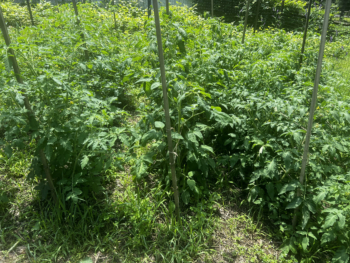
Tomato crop 50 days after transplanting, July 10. Photo: Lee Rinehart, NCAT
One option I am thinking of for getting summer transplants into early-terminated cover crops when the temperatures are too low for timely cover crop decomposition is to use winter-killed cover crops instead. This fall, I’ll likely plant oats and winter peas, which will die in the winter. In the late spring, my tomatoes can be planted earlier into the decomposed mulch. I have never experimented with winter killed covers, so I know I will have to pay attention to nitrogen next year and side dress if needed. It will be a good learning experience to see how nutrient carryover from winter killed covers compares with spring killed covers.
Using cover crops at this scale is fun, it’s an adventure, and it’s practical. Buckwheat grows wicked quick in the summer, making it a great cover between early summer and fall crops. Rye and vetch have amazing yields and, seriously, crops that follow them just don’t need fertilizer (unless I am nervous… which admittedly I am at times. A handful of bloodmeal may do no more than give me the warm-and-fuzzies, but I still do it). Even the pollinator crops are covers providing multiple benefits.
Eliot Coleman once said green manure and cover crops and crop rotations are public commons, so corporations can’t make money off them. Maybe that’s why their use on American farms is still excruciatingly low. As for the Mad Farm and hundreds of farms and gardens like mine, we’ll take hope, connection, and resilience, and will each day try to do something that doesn’t compute.
Related ATTRA Resources:
Toolkit: How to Reduce Synthetic Fertilizer Use
Growing Hope: Fertilizer Reduction
This blog is produced by the National Center for Appropriate Technology through the ATTRA Sustainable Agriculture program, under a cooperative agreement with USDA Rural Development. ATTRA.NCAT.ORG.

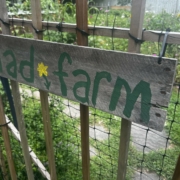
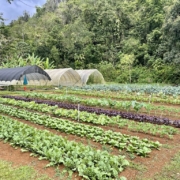 NCAT
NCAT

